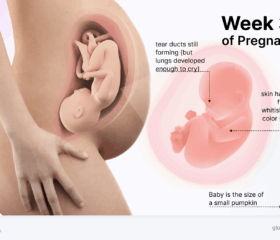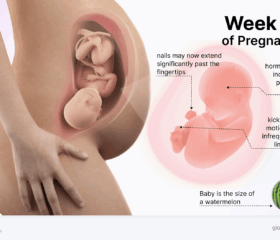How to Naturally Induce Labor: 11 Claimed and Guaranteed Methods
As your due date gets closer, you may feel increasingly impatient to meet your baby—which may, in turn, make you wonder if there’s a natural way to induce labor.

After 9 long months, many moms just want their pregnancies to be over already. This leaves them looking for ways to naturally induce labor.
There are a lot of purported methods of labor induction, most of which have only anecdotal support, although others have a bit more science behind them.
Let’s take a look at some of the supposed “natural” methods to get your baby moving along and whether or not they’re effective (and safe).
Why it’s usually better to let labor begin naturally
Before we get deep into the weeds of at-home labor induction, it’s worth noting that doctors generally recommend sitting tight and waiting until your body is ready to give birth.
This is true even if your estimated due date (EDD) has come and gone. After all, your EDD is just an estimate, as the term suggests. Many healthy pregnancies are a little longer or shorter than projected.
Unless there’s a medical reason, it’s best to wait for labor to begin naturally. 1 This gives your baby time to fully develop, which means he’ll have: 2
- More muscle strength
- A reduced risk of complications like infection, low blood sugar, and jaundice
- Improved breathing and lung development
- Better feeding ability
- Increased brain development
Moreover, induced labor is more likely to require some form of medical intervention, such as a C-section or the use of forceps, which can make your recovery time much longer. 1
When and why doctors sometimes induce labor
Although it’s usually better to let nature take its course, there are certain scenarios where your doctor will recommend inducing labor, such as if: 3
- Your pregnancy lasts too long: After 42 weeks, your placenta might not work as effectively as before. Your baby may also become larger than average if he’s still in the womb, which could cause complications during delivery.
- There’s a problem with your placenta: If your placenta separates from the uterus (known as placental abruption) or your amniotic sac gets infected, your doctor may recommend inducing labor.
- Your water breaks too early: Your amniotic sac (the bag of fluid that covers your baby) may break before you start going into labor, known as premature rupture of the membranes (PROM).
- You have a preexisting health condition: If you have health issues like diabetes or preeclampsia, you might need to have labor induced. A condition called oligohydramnios also causes you to produce insufficient amniotic fluid and warrants inducing labor.
- Your baby has stopped growing: If your baby stops growing or his growth has slowed down too much, labor induction may be necessary.
- You’re carrying multiples: Your doctor may induce labor to prevent complications such as stillbirth, which are more likely with multiple pregnancies carried to term. 4 (It isn’t guaranteed that they’ll recommend induction, and it’s possible they’ll elect for a C-section or decide that it’s better for you to give birth naturally instead—that depends on your circumstances.) 5
Can you ever choose to have labor induced?
If you want to have labor induced for a non-medical reason, such as if you live far away from a hospital or birthing center, this is known as an elective induction.
Elective induction is relatively rare, and many doctors are reluctant to allow it. This is especially true if you’re less than 39 weeks pregnant, as inducing labor before then can be dangerous. 6
If you’re determined to get an elective induction, your doctor will probably only allow it if: 6
- You’re 39 weeks pregnant or more
- Your cervix is soft and ready to open (dilate)
- You haven’t previously had a C-section or a major surgery on your uterus
Evidence also suggests that induction is riskier if this is your first pregnancy, as that increases the risk of certain labor complications, such as shoulder dystocia (when one of your baby’s shoulders gets stuck in your pelvis). 7
7 natural methods claimed to help induce labor
There’s no shortage of tricks and folk methods that have been claimed to induce labor, but whether or not they actually work is up for debate.
To satisfy your curiosity, we’ve listed some of the most commonly recommended methods below. Don’t put too much stock in these, and if you decide to give any of them a try, run it by your doctor first.
1. Going for a brisk walk
The idea here is that gravity during a walk encourages your baby to descend into your pelvis. This puts pressure on your cervix, which might help it ripen for labor. 8
Unfortunately, there’s very limited evidence that suggests this can actually induce labor. 9
With that said, regardless of whether or not walking can induce labor, it’s a great idea to stay active during your pregnancy. Regular (moderate) exercise keeps your body strong and can reduce stress. 10
2. Sex
Some moms swear that getting frisky is a reliable—and fun—way of inducing labor. Since orgasms release oxytocin (one of the hormones that stimulates uterine contractions), proponents claim that this can kickstart labor. 11 12
Moreover, semen contains prostaglandins, which help ripen your cervix. 13
Before you jump into the bedroom, note that here again, there’s limited evidence that sex can truly start labor. However, unless your water has broken or your doctor has advised against sex during pregnancy, there’s no harm in trying. 14
3. Acupuncture and pressure
You may have heard that the traditional Chinese medicine technique of acupuncture can induce labor. The acupuncture process involves inserting very thin needles into particular points on the body.
While some studies suggest that acupuncture might promote cervical ripening, there’s little evidence that either it or the related technique of acupressure can induce labor. 9 15
4. Herbal remedies
Some people suggest that herbs, including red raspberry leaf, black cohosh, and evening primrose oil, can prepare your body for labor.
Most of these herbal remedies haven’t been well-studied. In fact, they could actually pose risks for you and your baby.
Cohosh, for example, may have the potential to cause fetal heart failure or strokes, alongside maternal complications during labor. It’s best to give all of these purported natural remedies a miss unless your doctor explicitly clears any of them. 9
5. Eating dates
Oddly, there’s some research that suggests eating dates in the final weeks of pregnancy may lead to increased cervical dilation and ripening. 16
There’s no guarantee this will work for you, but dates are a healthy snack, so even if they don’t get your baby moving, a handful won’t do you any harm. 17
6. Eating spicy food
Could that bottle of hot sauce give your baby the push he needs to leave the comfort of the womb? Proponents claim that stimulating your intestines with spicy food can start your contractions. 18
This probably isn’t true, and overdoing it with peppers could leave you with heartburn or indigestion, but if you do give it a try, it won’t do any lasting harm. 19
7. Castor oil
In the past, castor oil was used to kickstart labor. While castor oil can stimulate your bowels and might cause uterine contractions, it can make you feel sick and may also cause vomiting and high blood pressure, so this is another method to give a pass. 17
5 legitimate ways of inducing labor
While the methods for inducing labor listed above aren’t grounded in science, there are a few proven ways to encourage your little one to get moving.
1. Nipple stimulation
Stimulating your nipples manually or with a breast pump can encourage uterine contractions by boosting your oxytocin levels. 20 21
However, you should only try this out with your doctor’s oversight, as the method can be a little risky.
Under your doctor’s supervision, you can use your fingers, have a partner assist, or use a breast pump to stimulate your nipples. Studies suggest you need to do this for one to three hours a day to see results—you probably won’t go into labor right away. 22
2. Mechanical labor induction
Your doctor can manually induce labor by using one of three mechanical methods: 23
- Transcervical balloon catheter: This is the most widely used mechanical method. Your doctor can inflate a type of balloon catheter in your cervix to “ripen” and dilate it. They’ll either use a single balloon catheter, sometimes called a Foley bulb, or a double balloon catheter, known as a Cook catheter. Both the single and double balloon variants are very effective.
- Osmotic cervical dilator: With this method, your doctor will place hygroscopic (moisture-retaining) rods into your cervical canal. These rods will expand as they absorb moisture, which causes your cervix to dilate.
- Extra-amniotic saline infusion (EASI): Your doctor will place a catheter through your cervix and infuse saline into the space between your uterine wall and your baby’s membranes, causing your cervix to ripen. This method isn’t as common as the balloon catheters mentioned earlier, but it’s still effective and safe.
Your doctor will usually opt for one of these mechanical methods if your cervix isn’t ready for labor (i.e, it hasn’t dilated or ripened). They tend to have lower risks than pharmacologic methods of inducing labor.
3. Membrane stripping or sweeping
Only your doctor can strip or sweep your membranes. This is not something you can do at home. Your doctor will insert a finger through your cervix and move it around to separate your baby’s amniotic sac from your uterine wall. This action can trigger the release of prostaglandins and potentially start labor. 24
Your doctor won’t usually offer this until after 39 weeks, when your cervix has already started to dilate. While it may help, it’s also not a guaranteed method and works best if your body is already close to labor.
You can’t use membrane stripping or sweeping if you’re group B strep-positive
If you’re group B strep positive, membrane sweeps can increase the risk of infection for your baby. Your doctor won’t recommend this method if you are.
4. Using medication to induce labor
Your doctor may give you medication that’ll induce labor. Oxytocin (Pitocin) tends to be the most common medication, which your doctor will insert intravenously to start your contractions or make them stronger. They’ll give you a small, steady dose until your contractions start, after which they may reduce the dose or stop it altogether.
However, you might not be able to use oxytocin to get things going if your baby isn’t getting enough food or oxygen through the placenta. 25
Your doctor could also use one of the following medications to ripen your cervix if it hasn’t started already:
- Misoprostol (prostaglandin E1)
- Dinoprostone (prostaglandin E2)
- Mifepristone (less common than the other medications)
As with all methods of medical induction, your doctor will only recommend this if they conclude it’s safe.
5. Amniotomy
During an amniotomy, or artificial rupture of the membranes (AROM), your doctor will insert a small plastic hook into your cervix to manually break your amniotic sac. You’ll feel a gush or trickle of amniotic fluid from your vagina, followed by more intense contractions. 26
Your doctor will only be able to perform this procedure if your cervix is already partially dilated and effaced (thinned and softened). 27
What is the quickest way to induce labor?
Since most natural methods for inducing labor aren’t reliable, the quickest, most effective, and safest means of labor induction are those performed by doctors.
Generally, a combination of methods, such as receiving Pitocin (oxytocin) in an IV along with an amniotomy, is the fastest way to induce labor. 27
Your doctor will decide which method is best for you depending on your health and your baby’s condition.
Final thoughts
Unfortunately, most natural methods of inducing labor aren’t reliable. If you’re at all concerned that your baby is taking too long to come out, speak with your doctor. They’ll let you know if it’s medically necessary to induce labor and help you push through this last lap of your pregnancy marathon.
Article Sources
- South Carolina Department of Public Health. "Why is it Important to Wait for Labor?" Retrieved October 21, 2025.
- Mississippi State Department of Health. "39 Weeks for Healthy Baby" Retrieved October 21, 2025.
- March of Dimes. "Medical reasons for inducing labor" Retrieved October 21, 2025.
- Tommy’s. "Giving birth to multiple babies" Retrieved October 21, 2025.
- BMC Pregnancy Childbirth. "Cesarean delivery or induction of labor in pre-labor twin gestations: a secondary analysis of the twin birth study" Retrieved October 21, 2025.
- LifeBridge Health. "Elective Induction" Retrieved October 21, 2025.
- JAMA Network. "Comparison of Maternal Labor-Related Complications and Neonatal Outcomes Following Elective Induction of Labor at 39 Weeks of Gestation vs Expectant Management" Retrieved October 21, 2025.
- Journal of Maternal-Fetal and Neonatal Medicine. "Physical exercise at term for enhancing the spontaneous onset of labor: a randomized clinical trial" Retrieved October 21, 2025.
- UT Southwestern Medical Center. "The truth about “natural” ways to induce labor" Retrieved October 21, 2025.
- Journal of Sport and Health Science. "Walking for health during pregnancy: A literature review and considerations for future research" Retrieved October 21, 2025.
- Journal of Men's Health and Gender. "Gender differences in sexual motivation" Retrieved October 21, 2025.
- MedlinePlus. "Oxytocin Injection" Retrieved October 21, 2025.
- Cochrane Database of Systematic Reviews. "Sexual intercourse for cervical ripening and induction of labour" Retrieved October 21, 2025.
- Nemours KidsHealth. "Sex During Pregnancy" Retrieved October 21, 2025.
- Cochrane Database of Systematic Reviews. "Acupuncture or acupressure for induction of labour" Retrieved October 21, 2025.
- Iranian Journal of Nursing and Midwifery Research. "Effect of Dates in Late Pregnancy on the Duration of Labor in Nulliparous Women" Retrieved October 21, 2025.
- Tommy’s. "Can anything bring labour on?" Retrieved October 21, 2025.
- Birth. "Women's use of nonprescribed methods to induce labor: a brief report" Retrieved October 21, 2025.
- Nemours KidsHealth. "How Can I Deal With Heartburn During Pregnancy?" Retrieved October 21, 2025.
- MedlinePlus. "Monitoring your baby before labor" Retrieved October 21, 2025.
- Cochrane Database of Systematic Reviews. "Breast stimulation for cervical ripening and induction of labour" Retrieved October 21, 2025.
- PLOS One. "Effects of breast stimulation for spontaneous onset of labor on salivary oxytocin levels in low-risk pregnant women: A feasibility study" Retrieved October 21, 2025.
- Cochrane Database of Systematic Reviews. "Mechanical methods for induction of labour" Retrieved October 21, 2025.
- Nemours KidsHealth. "What if My Baby Isn't Born by My Due Date?" Retrieved October 21, 2025.
- MedlinePlus. "Inducing labor" Retrieved October 21, 2025.
- Cleveland Clinic. "Amniotomy" Retrieved October 21, 2025.
- Cleveland Clinic. "Induced Labor" Retrieved October 21, 2025.







